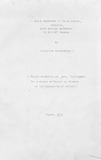| dc.description.abstract | Authorized marketing of maize, the main staple food in Tanzania, is performed through a 'one channel' market system. Between 1963 and 1973 the above market channel consisted of primary co-operative societies, co-operative unions and the National Agricultural Products Board (N.A.P.B.). Subsequently the Board has been superseded by the National Milling Corporation (N.M.C.), and the co-operative unions ceased to have any direct role in maize marketing.
Producer prices were, until July 1973, determined by the Government after the marketing costs of the various agencies had been calculated. Because of the method adopted in price determination, producer prices varied from area to area depending on the relative efficiency of the local marketing institutions.
A system of uniform pan-territorial producer price was introduced in 1973.
The marketing of maize through the above so-called
official channel system has been unsatisfactory in several respects, including high operating costs per unit and poor marketing services. Not surprisingly,
a high proportion of the marketed crop does not go through the official channel but through private and unauthorized traders. Most of the blame for the inefficiency of the 'one channel' system has been placed on the 'Co-operative Movement.' In response to the above criticisms, the co-operative unions' participation in maize marketing was terminated in 1974.
This study is an attempt to determine the benefits which producers and consumers can derive from the 'shortened' market chain. The rationale for the existence of illicit maize trade is examined.
(xi>
The study was conducted in Tanga, one of the principal maize producing regions in Tanzania. Primary data were obtained from random samples of 10 farmers from each of 8 selected primary co-operative societies and from officials of these co-operative societies. Other sources of primary information included informal personal interviews with officials of Ministry of Agriculture, the National Milling Corporation and Tanga Region Co-operative Union.
The marketing margin, cost structure and quality of marketing services, are all examined during the period immediately before and after co-operative unions ceased to be part of the marketing chain.
Causes of illicit maize marketing are also investigated.
The study shows that a wide range of physical marketing problems experienced by farmers has led to illicit trading. The study also reveals that marketing
services provided by private traders have been far better than those provided in the official channel. This has been the major inducement for farmers to sell to private traders. The official price of maize relative to that of other crops, is also seen to have an effect on quantities of maize channeled through the official market system. Terminating co-operative unions from maize trade is found to have an effect of reducing the marketing margin. Another finding of the study is that "ever since primary co-operative societies and the N.M.C. became the only authorized maize dealers several major improvements in marketing services have been made. The improved services include collection, speed of produce purchase and payment, and an increase in the number of buying * posts.
1
The study reveals, however, that while efficiency in maize marketing is rising, there is room for further improvement. There is a need to improve institutional marketing facilities such as storage and transportation. The study also shows that further reduction in the marketing margin can be effected if shrinkage losses are reduced. The answer here seems to be one of creatin quality competition to stimulate farmers to practice more careful sorting and grading before sale.
Decentralization of primary co-operatives through operation of buying posts should be approached more cautiously. The setting up of buying posts, it is suggested, should be based on strict viability criteria covering sufficient volumes of throughput. Whenever possible, buying posts should be amalgamated to increase throughput and decrease marketing costs.
The survey showed that provided that the above
improvements in the official marketing system prevail,
farmers are much less willing to participate in illicit *
maize trading. | |

